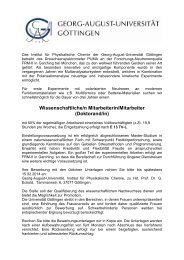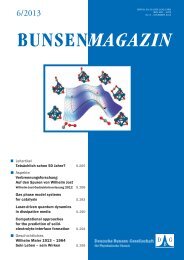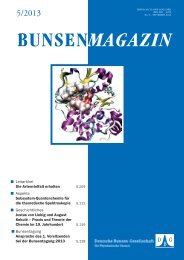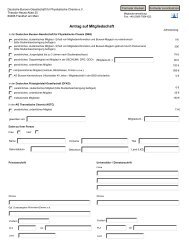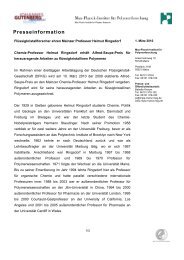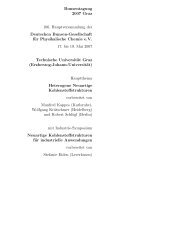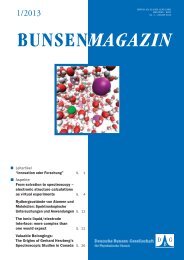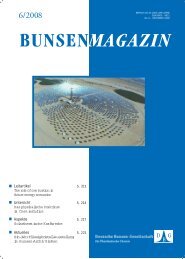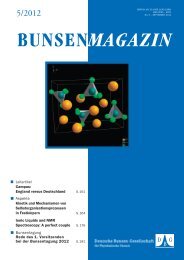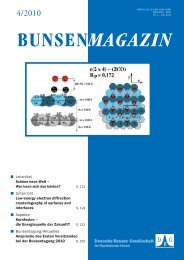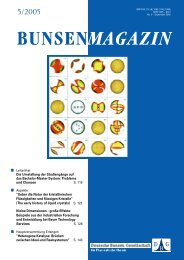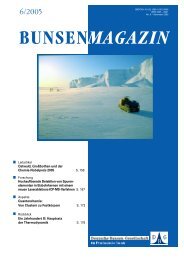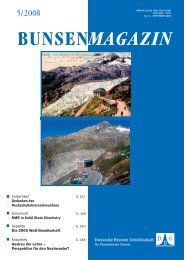BUNSENMAGAZIN - Deutsche Bunsengesellschaft für ...
BUNSENMAGAZIN - Deutsche Bunsengesellschaft für ...
BUNSENMAGAZIN - Deutsche Bunsengesellschaft für ...
Erfolgreiche ePaper selbst erstellen
Machen Sie aus Ihren PDF Publikationen ein blätterbares Flipbook mit unserer einzigartigen Google optimierten e-Paper Software.
DEUTSCHE BUNSEN-GESELLSCHAFT<br />
UNTERRICHT<br />
Figure 19: Self-aggregation of functionalized polyphenylene dendrimers with a) short (n < 16) and b) rather long (n > 20) peptide side chains. Right) representative<br />
RE-REDOR sideband pattern analysis: the continuous drop of the local order parameter S indicates the mobility gradient.<br />
In this case, local segmental dynamics of both the dendritic<br />
sidechains and the aromatic core were determined in detail<br />
by means of 1 H- 13 C and 1 H- 1 H NMR. Within the solid phase, the<br />
aromatic core forms well-ordered, rather rigid columnar stacks<br />
(p-stacks) that possess a particularly high photoconductivity. 76<br />
After preassembly, self-organisation occurs in the liquid crystalline<br />
phase, in which the core is mobilized. Depending on the<br />
actual dendron, this is refl ected by a more or less reduced (local)<br />
dynamic order parameter and can be attributed to either<br />
small angle librations or out-of-plane motions. In any case,<br />
the hexagonal columnar stacks are maintained. The structure<br />
formation is governed by dendritic sidechains und their local<br />
packing rendering stabilization of the columnar stacks due to<br />
p-interactions rather negligible. Dendritic building blocks of<br />
this kind therefore constitute an example where self-organisation<br />
of molecules into functional aggregates can be driven<br />
by fl uorophobic effects. The most prominent feature of such<br />
stacks, however, is their (rather rare) ability to self-repair intracolumnar<br />
structural defects as demonstrated by 1 H- 1 H doublequantum<br />
2D-NMR. 75<br />
Self-organisation of building blocks can also be dominated<br />
by shape-persistent moieties such as polyphenylene dendrimers.<br />
78 While their size is tunable on a nanometer-scale by appropriate<br />
choice of dendrimer generations, self-organisation of<br />
the columnar stacks can be highly infl uenced by attachment<br />
of poly-L-lysine side chains. In case of short peptide chains<br />
(n < 16), the hexagonal ordering of the polyphenylene cores<br />
is essentially retained. Longer chains, however, perturb the<br />
order of the cores, where 13 C-CPMAS data indicates a rather<br />
well-defi ned secondary structure of the sidechains. It could be<br />
shown that peptide chains which are confi ned by the packing<br />
of the polyphenylene cores can adopt unprecedented secondary<br />
structure motifs not known for their linear analoga. On<br />
one hand, the effective dipolar order parameters derived from<br />
1 H- 13 C RE-REDOR measurements, indicate “frozen” polyphenylene<br />
cores. On the other hand, a mobility gradient was found<br />
ranging from the rather rigid peptide backbone to the fl exible<br />
sidechains (fi gure 19). 77<br />
3.4. SURFACES<br />
The high sensitivity of 1 H NMR facilitates the study of defect<br />
sites 79 and molecules adsorbed at surfaces (e.g. of nanoparticles).<br />
80 As in supramolecular systems, the structures of defects<br />
are rather diffi cult to characterize in industrially important microporous<br />
solids such as zeolites, 81 because defects that possibly<br />
present in the compounds are typically not ordered in the<br />
crystallographic sense and, therefore, are not easily amenable<br />
to analysis by diffraction methods. Both rotor-encoded doublequantum<br />
(RE-DQ) and triple-quantum (TQ) 1 H MAS NMR on siliceous<br />
as-made ZSM-12 independently revealed that at least<br />
three silanol groups are engaged in hydrogen bonding within<br />
the defect site, which in fact has important implications concerning<br />
the nucleation mechanism of high-quality zeolites. 79<br />
Figure 20: 2D- 1 H DQ spectra of HO 2 C(CH 2 ) 2 PO 3 H 2 (a) in the bulk state and (b)<br />
adsorbed in the nano-ZrO 2 . Note that the strong AC-DQ cross-peak reveals<br />
the formation of a hetero-dimer. 80<br />
Self-assembled monolayers are widely used to introduce different<br />
chemical functionalities on metals or metal oxides.<br />
High-resolution 1 H MAS NMR was used to characterize surface<br />
hydrogen-bonding interactions in adsorbed carboxyalkylphosphonates<br />
of varying chain lengths on zirconia and<br />
71



